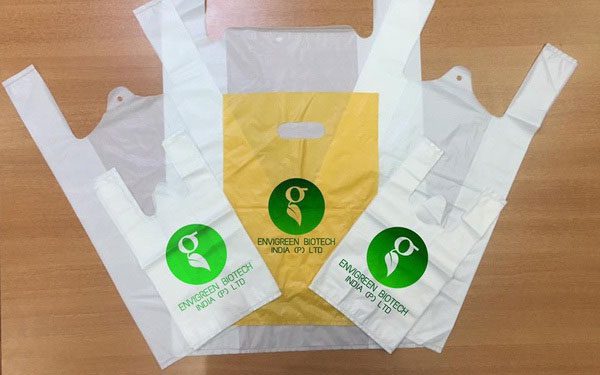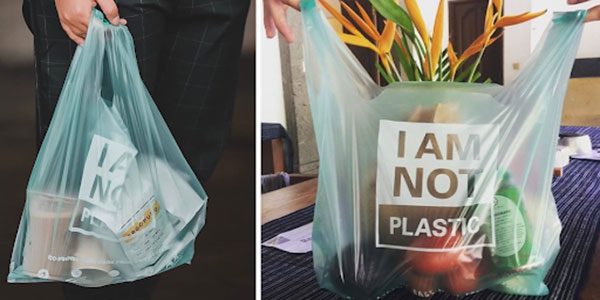The concepts of biodegradable plastic bags and compostable plastic bags are often confused, and very few consumers are aware of this.
Biodegradable Bags Still Pose Environmental Risks
Currently, in markets and supermarkets, biodegradable plastic bags are widely advertised. Biodegradable plastic bags and compostable plastic bags are different terms for the same type of bag that many people choose due to their reasonable price and perceived environmental friendliness. But are these bags truly safe for the environment?
In supermarkets, locally produced biodegradable food bags cost between 50,000 to 90,000 VND per roll, while imported bags from Europe range from 110,000 VND per roll. These biodegradable bags are usually white or transparent and feel smooth to the touch. Although they are thinner, they have similar durability and strength as traditional plastic bags. Compared to other plastic bags on the market, biodegradable bags are about twice as expensive.

Most plastic bags sold in supermarkets are biodegradable, not compostable. (Illustrative image).
Are these bags truly fully biodegradable, non-toxic, and environmentally friendly? Associate Professor Dr. Dang Thi Cam Ha from the Vietnam Academy of Science and Technology states that traditional plastic bags sold on the market are composed entirely of microplastic particles along with various additives for color, durability, and flexibility.
The biodegradable bags sold in the market contain not only microplastic particles (accounting for about 40% – 50%) but also other ingredients such as degrading additives, or some natural components like corn starch, tapioca flour, and wheat flour. Although they contain less plastic than conventional bags, fundamentally, biodegradable plastic bags are still plastic bags, with additives included to accelerate the degradation process.
According to incomplete statistics, each Vietnamese household typically uses 5 to 7 plastic bags per day, including large, small, and even mini bags… Millions of plastic bags are used and discarded into the environment daily. The degradation process of a single plastic bag can take anywhere from 500 to 1,000 years if it is not exposed to sunlight.
Read the Ingredients Carefully When Buying Plastic Bags
To meet consumer demand for biodegradable bags, many manufacturers have falsely labeled their bags as biodegradable to boost profits. If you decide to choose plastic bags, you should carefully read the ingredients used to make the bag. Additionally, you can determine whether a biodegradable bag is toxic by testing it. If the product burns easily without producing smoke, it indicates limited toxicity. Conversely, if the bag is difficult to ignite, produces smoke, or emits strange, burnt odors when burned, it may contain toxic substances.
Dr. Nguyen Chau Giang from Hanoi University of Science and Technology also believes that the nature of the biodegradable bags commonly sold in supermarkets today is completely different from compostable bags. This is because during the bag-blowing process, additional additives are mixed into the PE plastic, allowing them to decompose more quickly.
This means that in the environment, these plastic bags will break down and decompose faster, but the plastic components remain, accumulating in the environment as microplastic particles, which are very small in size. In contrast, compostable bags made from tapioca starch decompose into CO2, water, and biomass, without negatively impacting the environment and ecosystem.

When purchasing a product, you should carefully read the ingredients used to make the bag.
Associate Professor Dr. Dang Thi Cam Ha explains that plastic bags that are biodegradable but not compostable will break down into smaller pieces when disposed of in the environment, but the fragments remain, dispersing into the environment as microplastic particles. These enter the food chain of marine organisms.
The source of plastic pollution flowing into the ocean causes the oceans to suffer, leading to the gradual death of marine life and the destruction of marine ecosystems. Of particular concern is that small particles sized in the nanometer range will disrupt the nutrient cycles of marine animals. Additionally, smaller particles under 1mm can cause larger marine animals to die when they mistake them for food.
The presence of plastic bags in the environment severely impacts soil and water, as plastic bags mixed into the soil change its physical properties, leading to erosion, making it harder for the soil to retain water and nutrients, and preventing oxygen from passing through the soil, affecting plant growth.
“Even for biodegradable plastic bags, it does not mean they will decompose easily like leaves. Biodegradable bags need appropriate conditions, ensuring specific temperature, light, and humidity levels suitable for each type to decompose effectively.
According to information from manufacturers, these bags can decompose in a time frame of 6 months to 2 years, or even longer, depending on environmental conditions. Therefore, the use of plastic bags remains a burden on the environment. One should not think that using biodegradable bags allows for carefree consumption and usage as much as possible,” said Associate Professor Dr. Dang Thi Cam Ha.


















































